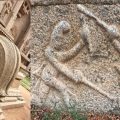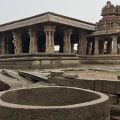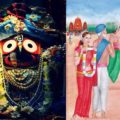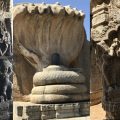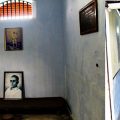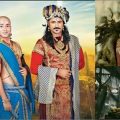Evergreen Hampi: Saga of Krishnadevaraya of Vijayanagara
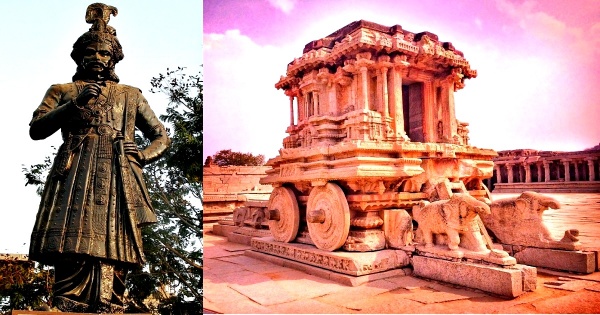
Evergreen Hampi is a book by Wing Commander Sudarshan on the temples of Hampi and the saga of Krishnadevaraya of the Vijayanagara Empire. Below are extracts from the book. The Kannada edition of the book titled Hasiru Hampe is already released and available in online platforms including Amazon, Flipkart.
Vitthalapura is our native village near Hampi. Our house stands between the river Tungabhadra and the Vitthala temple. Everywhere it is ‘Vitthala..Vitthala…’ around here and so it was natural that I was named Vitthalacharya. The city of Vijayanagara is surrounded by giant granite monoliths, making it look as if someone had stacked the boulders with precision. In fact, in and around Vijayanagara it appears that mother nature herself has played the role of a sculptor.
Being a family of professional sculptors, we grew up playing with stones…stones of various varieties like granite, soapstone, limestone, chalk stone. Our world revolved around the Vitthala temple. Our ancestors undertook extensive amounts of sculpting at various locations in the Karnataka kingdom. Stone carving was our childhood pastime too, and subsequently it paved our way to becoming the next generation sculptors. Our probation commenced with laying the foundation of a temple and by the time the tower of the temple was completed we would be skilled sculptors of our community. The construction of the next temple would take place under the leadership of the newly sculpted sculptor!
The younger lot of sculptors got excited when King Krishnadevaraya told us about his dream project… to build a Rangamahal with fifty six musical pillars next to the Vijaya Vittala temple. Each pillar would have seven sub pillars called ‘Nada Sthambhas ‘, which when tapped with the fingers would play musical notes… Sa.. Re.. Ga.. Ma. Not only that, each pillar would emanate the sounds of different musical instruments.
We heard that some of the temples built by our forefathers Jakkanajja and Dankanajja had these kinds of music pillars built, but there may have been four or six of them. Now we have to build fifty-six of them…Is it possible ? Our elders were in a doubtful mood. Sculptors’ manual “Shilparatna Ajitagama” came out of cloth cover once again. Sculptors from Sringeri and Madurai were also invited. Discussions of sculptors continued day and night.
Hard granite boulders are abundant around Hampi. Limestone and chalk stones were brought from elsewhere. These rocks are to us what pieces of wood are to a carpenter and sheets of iron to a blacksmith. Rocks are the cornerstone of our art. Each rock has its own density. Each stone has its own wavelength and frequency.
To the common observer, all these rocks look the same but we who have grown knowing rocks with every breath recognise their characteristics very well. The lesson taught by our senior sculptors in gurukula since childhood is…
Every life and particle has its own wavelength and frequency. Similar to our body, every organ, cell has a wavelength, but we have to discover it ourselves..’.
There is no specific syllabus or curriculum to discover this, it is an intuition that we explore within ourselves. Meditation is the only way to do this, so we all have our training that begins with meditation. We are living beings and we possess a certain resonance …but to discover the wavelength of lifeless rocks?
To realise that stones also vibrate with their own frequencies we have to change them from solid state to liquid state, i.e. the stones have to be melted! Every stone has some mineral content. Every mineral melts at a certain boiling point. Thus, the density of rock containing different minerals changes. During that time, mixing with other types of rocks and sand changes the density of the rock, its resonating frequency changes and the sound emitted from it changes. It becomes Shilaras, in this state it must be transformed into a specific shape before being cooled and hardened. The broad base, narrow top shape of the composite stone is called “Stree Shila”. If it is tapped, it emits sounds of string instruments like veena, saptaswara, panchatala and jaltaranga. A conglomerate that is parallel from the base to the top is called “Pum Shila ”. From this the sounds of percussion instruments like mridanga, tabla and damaruga comes out. Also “Napams Shila” is used to create dull sounds and also acts as the load bearing member of the pillar.
After the detailed discussion among senior sculptors, an action plan was formulated. Accordingly a huge workshop was constructed in the rear premises of the Vijaya Vitthala Mandir. A big furnace was built there. With the help of elephants, rocks of various size, shape and type were rolled into the temple premises. It took hundreds of people to crush the rocks that were brought in. Blacksmiths with experience in liquefying metals joined the team. Experts in science of densities and wavelengths also joined hands. The help of potters was taken to make a colossal turning machine. After making hundreds of composite pillars of specific size, they all left and our main work started. In the next step we all started learning the frequencies of the percussion instruments. Listening with intense concentration to the sound waves of panchatala, tabla, mridanga, jaltarang and maddale, and tune the kambhas to the same specific sound.
As per the predetermined plan, sixteen pillars would be erected in the centre of the Ranga mandapa in a square shape. Another forty pillars were to be erected around the mandapa. Each pillar was carved precisely to eleven feet and ten inches.
The central pillar is the base pillar. And around it there are seven swara sthambhas. These sthambhas produces the musical notes in an orderly manner. But their final carving would have to take place inside the Rangamantapa. The design carved on the ceiling of the theatre was created in a unique way. The musical tones produced from the swara sthambas were modulated by this concave dome called Madhyamandala in the inner roof, so it was here that their final tonal quality was checked. The senior sculptors used to do the precise carving according to the resonant wavelength of each pillar. All this work was done in a quiet environment. The gross stonework happened during the daytime and the fine carving happened in the deep silence of the nights. This part of the sculpting took place in a certain meditational trance until the sound of the instrument came out perfectly.
Rani Chinnamma Devi used to bring a team of music experts to check the sound quality of these fifty six pillars. Whenever the tone of some of the pillars was not right, that pillar was rejected. Another set of musical pillars with the set of swara stambhas were rebuilt in the silence of the night. Even the music experts were working with us all night until the notes were perfect. The queen Chinnamma Devi was looking at such a wonderful miracle with amazed eyes.
By the time news of yet another victory of Krishnadevaraya’s army in Kalinga desha reached Vijayanagara, the work of this wonderful Ranga Mantapa also got completed. Rani Chinnamma Devi was eagerly waiting for the opportunity to watch the dance performance of the Royal troupe along with the King Krishnadevaraya in this newly created Symphony in Stones.
We eagerly awaited the arrival of victorious King Krishnadevaraya.
‘Oh, Sri Sāluva Gajasiṃha what happened?’
I heard the voice of Krishnadevaraya who had just entered the inner chamber, Behind him, followed a large group of physicians and others. To me, Kumara Veerayya of Srirangapatna, King Krishnadevaraya is my Son-in-Law in relation but I am the vassal of the Kingdom by status. Notwithstanding the complexity of our relationship, we share a very friendly and informal bond between us. Although I am not from the Saluva clan the King jokingly addresses me as ‘Sāluva Gajasiṃha’. Right from the rule of the previous clan Saluva, we have been the loyal vassals of Vijayanagara and have fought and won many wars for the Kingdom and that’s how I received the title Gaja Simha a combination of elephant and lion. When I received this title, I was merely a young man of twenty. Currently, the lineage of the Tuluva dynasty reigns in the Vijayanagara Empire, so no one called me by this title except for Krishnadevaraya. From my son-in-law, one must learn how to respect others, as Krishnadevaraya’s magnanimity is such that one must emulate. Our loyalty to the empire is beyond question. As the province expanded, Srirangapattana became the central part of our territory and all administrative and executive matters were moved from Nagamangala to Srirangapattana. Our neighbour Samanta of Ummatur, Gangaraja, became jealous of our expansion and was waiting for an opportunity to attack us.
At that time, Krishnadevaraya had not yet ascended the throne. According to Thimmarasa’s prediction, a threat to Krishnadevaraya’s life loomed, which led to him hiding in Srirangapatna for some time. That period turned out to be a boon in disguise to our province because Krishnadevaraya being an able warrior himself, personally trained our army. The association between Krishnadevaraya and our soldiers was so strong that our soldiers were in awe of Krishnadevaraya’s charisma. At the same time, those who dared to face his sword could not escape his wrath. He selected four hundred soldiers personally and trained them making it a strong and formidable army. We then had enemies on two fronts, on one side, there was the feared Gangaraja of Ummatur, and on the other, the ruler of Mysore. It seemed like both of them were waiting for the right time to defeat us. A clever strategy was devised to deal with the arrogance of the rulers of Mysore and Ummatur. They were both attacked simultaneously and defeated. Krishnadevaraya’s military strategies were thoroughly researched, planned and executed at the right time. He waited for the onset of monsoon season when the Kaveri River would be swollen. Gangaraja the ruler of Ummatur, did not know of the presence of Krishnadevaraya in Srirangapatna’s army. His forces attempted to defend against our troops, they were camping in Thirumalakodu and on the southern banks of the river at Narasapur. Eventually, the heavy rains caused the Kaveri River to overflow. Gangaraja realised that if they don’t surrender to Srirangapattana they would all drown in the river Kaveri and they meekly surrendered. Most of the regions under Ummatur’s control, including Shivanasamudra, came under the authority of Srirangapatna.
Later when Krishnadevaraya ascended the crown, he married my daughter Tirumalambey and she became the queen of Vijayanagara. As long as Krishnadevaraya was in Srirangapatna, both he and his queen would attend the evening pooja at the Sri Ranganatha temple without fail. It was there on the temple’s premises that they came to know of a poet who was composing verses. His name was Nandi Thimmana. They were both impressed by his writings. Later, when they invited him to Hampi to translate the Mahabharata into simple Kannada. Nandi Timmana accepted their invitation and decided to stay in Hampi permanently.
Krishnadevaraya also undertook an expedition to the Nilgiri region along with my daughter. They were welcomed by the tribes of Badaga, Todu, Kota, and Kurumba. The tribal community was living in a dangerous environment. On one side there was a threat of wild animals and on the other side the outsiders who came to exploit the wealth of the forest produce and exploited the inhabitants of the forest. The tribal leaders requested the King to provide them protection from the wild animals and the external invaders. Krishnadevaraya immediately swung into action. He created a forest army consisting of the local youth and formed a force of 100 soldiers to guard the region against outside aggressors. The weapons were procured and training was conducted on the use of weapons. The military strategy employed by Krishnadevaraya during his rule, along with the dynamics between different rulers and the assimilation of newly acquired territories into his domain showcasing his cleverness and ability to plan and execute successful military campaigns is well known but to care for the neglected population of those tribes manifested his magnanimity.
Amidst recalling all those sweet old memories, I heard the voice of Krishnadevaraya ‘Oh, Sri Saluva Gajasimha…what happened?’
I had already been nursing a wound on my leg during this Raichur Campaign and all the while trying to keep it hidden from Krishnadevaraya. But somehow, someone has managed to inform him about it now and the King has come to inquire about my condition. The group of physicians got busy attending to my wounds and they assured the King, who was visibly upset about my condition, that I would be alright in a couple of days. The king briefed me about the successful takeover of the Raichur Fort. No one was unnecessarily injured or killed in the process and all the citizens especially the women and children were assured of their safety. After certain negotiations the fort was once again handed over to the rightful rulers.. The war is over and we are now ready to return to Hampi….
That brought so much joy to my fatigued soul. Finally, the war was over, the Vijayanagara Army had won once again and returning to Hampi now. I will be able to see my daughter and my grandson Tirumalaraya. Krishnadevaraya has built a new city in memory of his mother Nagalapura which is popularly known as Hosapete, another city is under construction honouring my daughter Tirumalamba called “Tirumalambapura,” taking the small village of Khudvadi as the centre and incorporating eight surrounding villages. I was told that the city would be developed very similarly to Srirangapattana so that my daughter would not miss her childhood hometown. Very thoughtful of the King I must say!
The thought that just in a few days we will be making a grand entry into the city excited me and I fell asleep with contentment.
The journey back to Hampi was a triumphant one. Krishnadevaraya’s army marched with pride, and the people of the conquered territories welcomed them as liberators. The news of the successful campaign had spread, and celebrations erupted in the villages along the way. The soldiers and the King were greeted with flowers, music, and dance. The air was filled with jubilant cheers as they approached Hampi. Upon reaching the grand capital, the city of Hampi, the entire population seemed to pour out onto the streets to welcome their beloved King and the victorious army. The city was adorned with colourful banners, and the temple bells rang loudly, signifying the festive spirit that filled the air.
As the procession entered the city, Krishnadevaraya rode on his majestic elephant, surrounded by his trusted ministers and warriors. I followed closely behind on my horse, grateful for the King’s concern for my well-being and for allowing me to take part in this glorious return. The people of Hampi showered us with love and admiration, praising the King for his wisdom, bravery, and benevolence. The streets were lined with spectators, eager to catch a glimpse of their beloved ruler and his victorious army. Children waved flags, and the elderly blessed the King as he passed by.
Finally, we reached the grand palace, where the King’s family and courtiers awaited to receive us. My heart swelled with joy as I saw my daughter, Queen Tirumalamba, adorned in royal attire, standing by her husband’s side. She looked radiant, and her eyes lit up with happiness upon seeing me. Krishnadevaraya’s eyes sparkled with pride as he presented his victorious army to the court. He spoke of our triumphs and praised the valour and dedication of each soldier. When he mentioned my role in the campaign, the courtiers erupted in applause, acknowledging the part I played in the victory. The King’s magnanimity knew no bounds as he rewarded the soldiers generously for their bravery. He provided aid to the families of those who lost their lives in battle and assured them that they would forever be remembered as heroes of the empire.
In the days that followed, the city of Hampi witnessed a series of grand celebrations. Festivals were organized, and the streets were illuminated with lamps and colourful decorations. Dances, music, and feasts filled the city with an infectious joy that transcended social barriers. As I spent time with my daughter and grandson, I couldn’t help but feel overwhelmed with gratitude for the King. Krishnadevaraya had not only been a great ruler but also a loving son-in-law and compassionate leader. His vision for a strong and prosperous empire, combined with his kindness towards his subjects and allies, was truly remarkable.
Amid the celebrations in Hampi, Krishnadevaraya called me to his side. He expressed his concern for my wound once again, assuring me that the best physicians in the kingdom would continue to care for me until I made a complete recovery. His genuine care and concern touched my heart deeply. As I looked at the King, I couldn’t help but feel immense pride and admiration for this extraordinary ruler. His military prowess was matched only by his humility and compassion. I felt blessed to have served such a noble and wise King. In the years that followed, Krishnadevaraya’s reign continued to bring prosperity and glory to the Vijayanagara Empire. His legacy of benevolence and wisdom echoed through the annals of history, and his name became synonymous with the golden era of the empire.
And so, the tale of Krishnadevaraya, the great ruler of the Vijayanagara Empire, and his trusted companion, the loyal vassal Sri Saluva Gajasimha, continued to be told and cherished by generations to come. Their bond of friendship and mutual respect stood as a shining example for all, inspiring countless souls to aspire to greatness, not just on the battlefield, but also in the way they cared for their people and their loved ones.
Wing Commander Sudarshan
Latest posts by Wing Commander Sudarshan (see all)
- Evergreen Hampi: Saga of Krishnadevaraya of Vijayanagara - July 27, 2024
- What the ‘Vaimanika Shastra’ Tells about Ancient Vimanas of India - July 27, 2024
- Temple Connection of India’s Primary Education: How British Destroyed It - July 27, 2024

